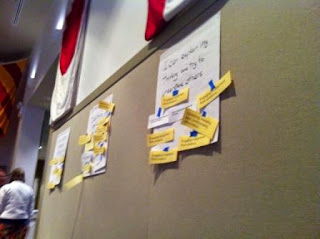Info about programs on the Trails of History this weekend can be found in the "About Us" section on the right side of your screen.
Earlier this week, a great bunch of people gathered at the
Pennsylvania Military Museum (thank you for hosting!) to explore Science, Technology, Engineering and Math (STEM) education as it relates to the work that museums and historic sites do. Thanks to Rhonda Newton of the
Pennsylvania Heritage Foundation, the program included Sally Flaherty and David Bauman, curriculum advisors (Social Studies and Science Education, respectively) from the
Pennsylvania Department of Education (PDE), as well as Jill Whelan from
Conner Prairie Interactive History Park (via Skype).
 |
| Connecting science, math, and history standards (photos by AKF) |
Staff from all over the Trails of History participated in discussions about STEM and how much of what they already do in their programming touches on these disciplines. Flaherty and Bauman shared with us PDE's working definition: "STEM education is an intentional, integrative approach to teaching and learning in science, technology, engineering, and mathematics. Students become adept problem solvers, innovators, and inventors who are self-reliant by asking questions, investigating, making informed decisions about how they live their daily lives and engage in their vocations and communities." They also walked us through an exercise that showed the connections between academic standards for scientific and mathemtatics practice and academic standards for history, in terms of the kinds of intellectual frameworks and activities that engage students.
It struck me that "integrative approach to teaching" and "asking questions, investigating" also describe the best ways that museums and historic sites help students (of all ages) learn about the past and how it relates to their lives. Hmmmm.
 |
| Skyping with Jill Whelan at Conner Prairie |
Whelan shared with us a bit about her experience working with front-line staff at Conner Prairie to help them be more comfortable talking with visitors about STEM. She also created a sample matrix that can be used to articulate the STEM concepts that are embedded in so many educational components and public programs at our historic sites, from cooking and food preservation, to gardening, to clothing, to transportation, to...you get my point.
 |
| Small group discussions |
Perhaps the best part of the day (shhh, don't tell our bosses) was the small group and large group discussion at the end of the day, where long-time and newer colleagues talked about how to apply what we heard and about what we, as a group, can do next. It has been quite a while since we got this bunch together and it was invigorating to see the possibilities for sharing expertise across sites. Stay tuned.






0 comments:
Post a Comment